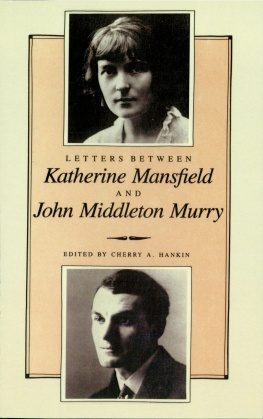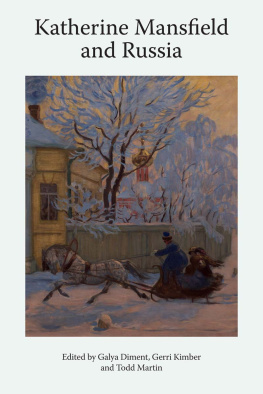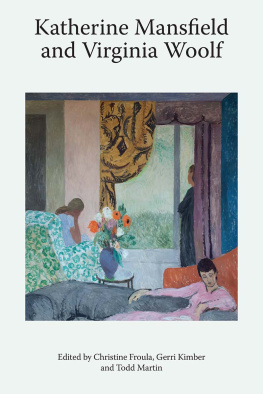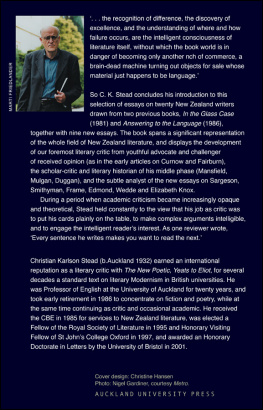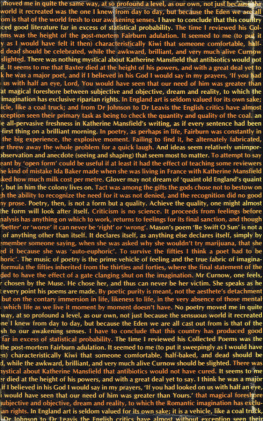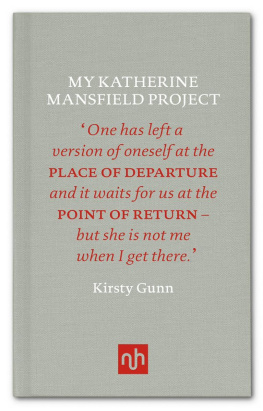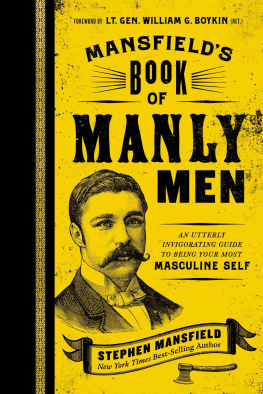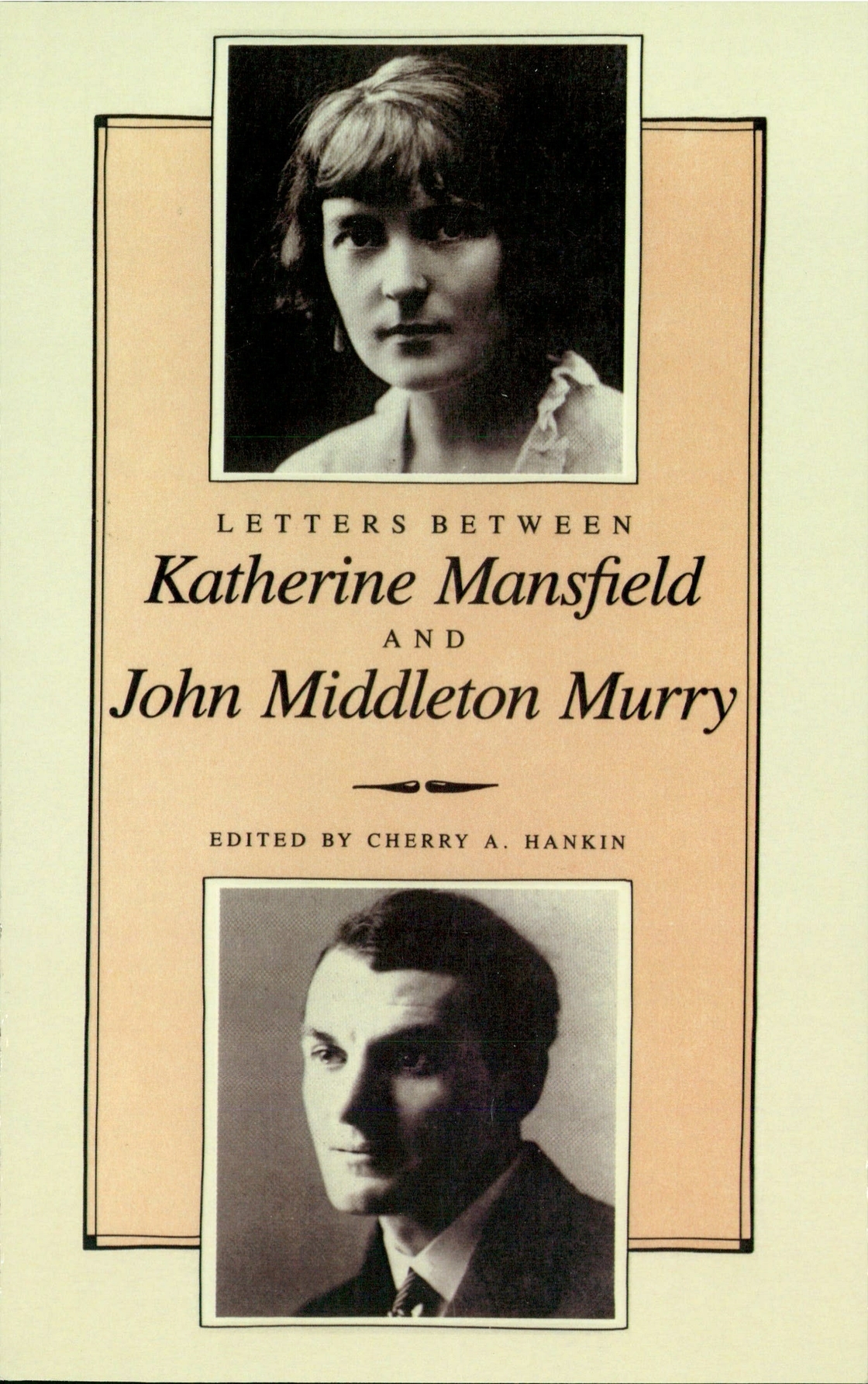By the same author
Katherine Mansfield and her Confessional Stories
The Letters of John Middleton Murry to Katherine Mansfield , (ed. C.A. Hankin)
Katherine Mansfield (1888 1923) was born Kathleen Beauchamp in Wellington, New Zealand. She was educated at Queens College, London, eventually settling in Britain in 1908. Her first volume of stories, In a German Pension , was published in 1911. In 1912 she met John Middleton Murry (1889 1957), then an Oxford undergraduate and editor of the modernist periodical Rhythm , and at her invitation he moved into her London flat. They became lovers (marrying in 1918), and together they edited the periodical until its collapse in 1913. Their relationship was stormy, alternating between intense love and virtual estrangement, and it was frequently punctuated by separations. At the request of Murrys friend, D.H. Lawrence, they spent some time living near the Lawrences in Cornwall, but relations became strained and Lawrence later portrayed Katherine and Murry as Gudrun and Gerald in his novel, Women in Love . In 1917 Katherine contracted tuberculosis and spent the remaining years of her life moving between London and France. During this period she was accompanied always by her lifelong friend Ida Baker (L.M.), or by Murry, who from 1919 to 1921 was editor of the Athenaeum , in which he published such fine writers as Virginia Woolf, T.S. Eliot, Paul Valry and Katherine herself. A further collection of Katherines stories, Bliss , was published in December 1920. But her health was deteriorating, and the following year she travelled to Switzerland, where she lived near her cousin, the novelist Elizabeth von Arnim. Finally, Katherine turned to the philosophy of Gurdjieff, entering the Gurdjieff Institute in Fontainebleau in 1922, the year she published The Garden Party . On 31 December she wrote to Murry, asking him to visit her; he arrived on 9 January, and she died that evening.
A year after Katherines death, Murry founded the Adelphi , and though he married again three times, remained dedicated to the publication of Katherine Mansfields works. Two collections of stories, The Doves Nest (1923) and Something Childish (1924), and the short novel The Aloe (1924), were edited and posthumously published by him, along with letters and reminiscences. In addition to these and his numerous critical works, Murrys autobiography, Between Two Worlds , was published in 1935.
Cherry Hankin was born in Nelson, New Zealand. After completing university and teachers training college, she lived in London and Montreal before enrolling for a Ph.D in English at the University of California in Berkeley. She returned to New Zealand on a Berkeley Advanced Graduate Travelling Fellowship to study the then unpublished papers of Katherine Mansfield held by the Turnbull Library in Wellington. After completing her Ph.D dissertation, a psychological study of Mansfield and her writing, she joined the Department of English at the University of Canterbury, where she specialises in teaching and writing about New Zealand and twentieth-century British fiction. She has published extensively on both Katherine Mansfield and John Middleton Murry, her major works including Katherine Mansfield and Her Confessional Stories (1983) and Letters of John Middleton Murry to Katherine Mansfield (1983). She has recently introduced five centennial editions of Mansfields stories, and is working on a new study of the relationship between Murry and D.H. Lawrence.
Endnotes
p.10 Aleister Crowley: (1875-1947), leader of an esoteric cult that dabbled in Satanism.
* Leon Engers Kennedy: a painter and early participant in Crowleys rites.
p.11 W.L.G[eorge]: 1882-1926) a novelist at whose house KM and Murry first met in 1911.
* the country: KM was planning to leave London for Cherry Tree Cottage in the country. Murrys feeling that she was withdrawing from him led to his addressing her as M.K.M. and saying that he wanted to get drunk.
p.12 New Age: the weekly review edited by A.R. Orage that first published KMs stories in London.
* Johnny F [ergusson]: (1874-1961), a Scottish painter who was art editor of Rhythm.
* Holbrook Jackson: (1874-1948), editor and writer who contributed to the Winter 1911 issue of Rhythm. In March 1912 he commissioned an article from Murry for T.Ps Weekly.
p.13 Macqueen: Willy Macqueen, a member of Frank Harriss circle.
p.14 Sydney Waterlow: (1878-1944), writer, diplomat and second cousin of KM.
* these Woolff people: Virginia and Leonard Woolf, writers and later publishers, were introduced to Murry by Sydney Waterlow.
* Gordon and Beatrice Campbell: (later Lord and Lady Glenavy), Irish friends of Murry who lived at 9 Selwood Terrace.
* Marcel Boulestin: a French writer who contributed to the Blue Review.
* Martin Secker: took over the publishing of Rhythm (later the Blue Review ) after November 1912.
p.16 Mrs Gom: helped with housework.
* I have begun the story: probably Millie, which appeared in the Blue Review in June 1913.
* Hugh Walpole: (1884-1941), novelist who contributed to the Blue Review and had written critically of some drawings in the May issue.
* George Banks: a female cartoonist who had contributed to Rhythm.
* Henri Gaudier-Brzeska: (1884-1915), French sculptor who had contributed drawings to Rhythm before quarrelling bitterly with KM and Murry.
p.17 Gilbert Cannan: (1884-1955), novelist and friend of Murry who lived next door in Cholesbury.
* Floryan Sobieniowski: (1881-1964), Polish translator and critic with whom KM became involved at Wrishofen in 1909. He cadged help from KM and Murry in 1912. In 1920 he blackmailed KM, demanding money for her Wrishofen letters to him.
p.17 Ida Baker (L.M. or Leslie Moore): (1888-1978), met KM at Queens College and remained her selflessly devoted friend.
* Mary Cannan: former wife of playwright J.M. Barrie, now married to Gilbert Cannan.
* George Bowden: (1877-1975), singing teacher whom KM married and immediately left in 1909. They were not divorced until 1918.
p.19 Lascelles Abercrombie: (1881-1938), poet, dramatist and critic who contributed to Rhythm and the Blue Review.
* Albert Rothenstein: artist and designer who contributed to Rhythm and the Blue Review.
* the epilogue: Epilogue: II, a short story later called Violet.
p.20 Frank Swinnerton: (1884-1982), prominent young writer who contributed to Rhythm.
* Denis Browne: the Blue Review s music critic.
* Arthur Ransome: (1884-1967), journalist and writer of childrens books.
* W.H. Davies: (1871-1940), Georgian poet who contributed to Rhythm and the Blue Review.
* the Royde-Smith: Naomi Royde-Smith, literary editor of the Saturday Westminster.
* Thomas Hake: a novelist and writer.
p.21 Richard Curle: (1883-1968), a writer and friend of Conrads who contributed to Rhythm and frequented its office.
* Edward Dominic Spring-Rice: (1889-1940), a writer on banking subjects.
p.22 Rupert Brooke: (1887-1915), war poet who contributed to Rhythm and the Blue Review.
* Charles Philippe: (1874-1909), French realist novelist.
p.24 R.C.: Richard Curie.
p.25 epilogue: Epilogue III: Bains Turcs, published in the Blue Review, July 1913.
p.28 a bleu: a telegram.
p.30 J.A. Spender: (1862-1942), editor of the Westminster Gazette.
* Bruce Richmond: (1871-1964), editor of the Times Literary Supplement.
p.36 D.H. Lawrence (Lorenzo): (1885-1930), and his wife Frieda, met KM and Murry in 1913. A close but difficult relationship developed between the two couples especially between Lawrence and Murry who lived near each other for periods between 1914 and 1916.

